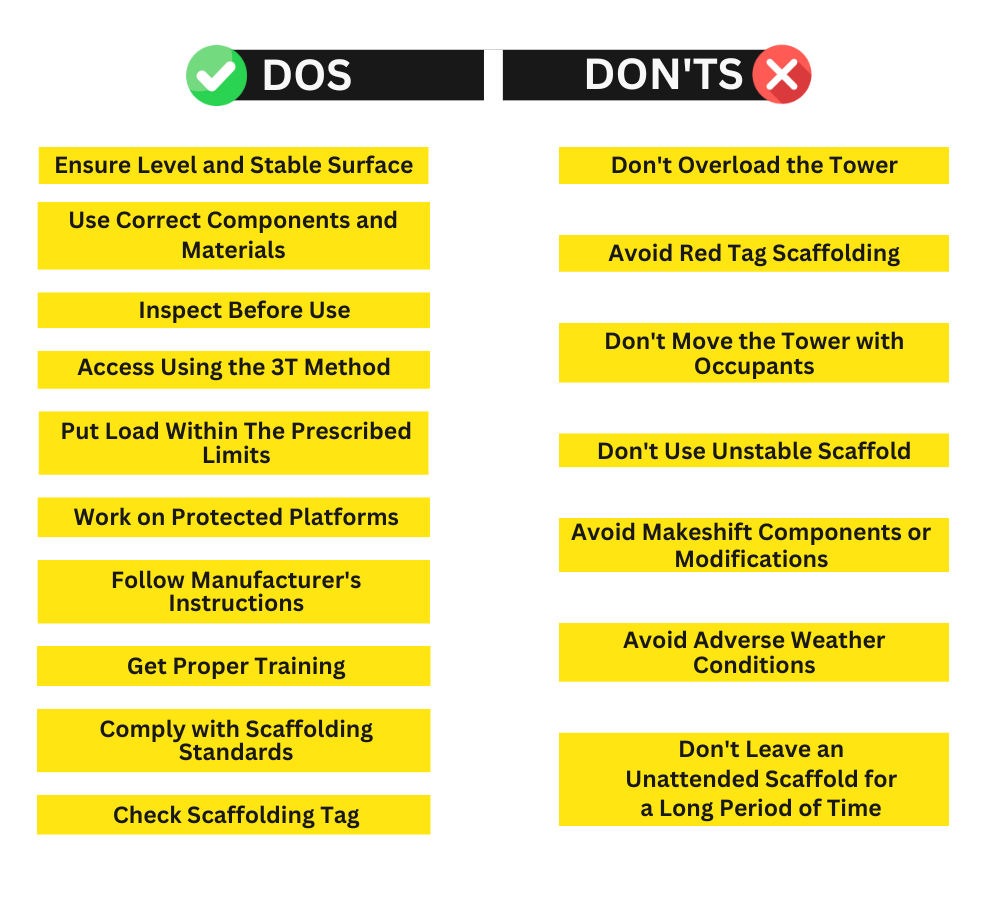In this guide, we'll keep it straightforward and easy to understand as we explore the key do's and don'ts of scaffolding. Whether you're a safety expert or maintenance professional in the worksite. These fundamental guidelines will help you work safely and efficiently with scaffolding. Let's get started!

The Dos of Scaffolding (Mobile Access Tower)
1. Ensure Level and Stable Surface
One of the fundamental aspects of scaffolding safety is to set up the tower on a level and stable surface. An uneven foundation can lead to instability and accidents.
2. Use Correct Components and Materials
Always use the correct components and materials designed specifically for towers. Using mismatched or inappropriate components can compromise the integrity of the towers.
3. Inspect Before Use
Before using the scaffold, conduct a thorough inspection to identify any defects or issues. Pay close attention to the fitment of braces, and platforms. If you spot any problems, report them and consult with the experts.
4. Access Using the 3T Method
The 3T (Through the Trapdoor) method is one of the safest ways to access a tower. This method involves climbing through a trap door or opening onto the platform rather than attempting to climb through the outside and other means.
5. Put Load Within The Prescribed Limits
Never overload the scaffold beyond its load capacity. Ensure that all materials and workers on the platform are within the prescribed limits to prevent accidents.
6. Work on Protected Platforms
Always work on a protected platform with guardrails and toe boards. This provides an added layer of safety by preventing falls from height.
7. Follow Manufacturer's Instructions
Manufacturers provide detailed instructions for the assembly and use of scaffolding systems. Always follow these instructions carefully to ensure safe operation.
8. Get Proper Training
Ensure that all workers using scaffolding have received proper training regarding the associated hazards and safe use of the equipment. This training is crucial for accident prevention. To ensure the worker's safety while using the mobile access tower we have received expert training from The Safety First services. This specialized training is the key to accident prevention, keeping your team safe and your projects on track.
9. Comply with Scaffolding Standards
Scaffolding standards exist to maintain safety in the industry. Familiarize yourself with relevant standards, such as EN1004 for mobile access towers, and ensure compliance.
10. Check Scaffolding Tag
Before using the scaffold, check the scaffolding tag. This tag provides essential information about the scaffold's inspection status and load capacity. Always use a scaffold with a green tag, indicating it's safe for use.
The Don'ts of Scaffolding (Mobile Access Tower)
1. Don't Overload the Tower
Never overload the scaffold with materials or personnel beyond its load capacity. Doing so can lead to structural failure and serious accidents.
Article: What are Scaffold Tagging and Types? Enhancing Safety at Height
Article: Top 7 Advantages of Aluminium Over MS Scaffold
2. Avoid Red Tag Scaffolding
A red tag on the scaffolding indicates that it is unsafe for use. Do not use scaffolding with a red tag under any circumstances. Report it to your supervisor for necessary correction or replacement.
3. Don't Move the Tower with Occupants
Moving the scaffold when workers or materials are on the platform is extremely dangerous. Always ensure that there should be no one on the scaffold while moving.
4. Don't Use Unstable Scaffold
Scaffolding should only be erected on a stable and level surface. Using it on uneven or unstable ground can result in collapse and accidents.
5. Avoid Makeshift Components or Modifications
Do not use makeshift components or make unauthorized modifications to the scaffold. Only use parts and accessories that are designed for the specific scaffold system.
6. Don't Leave an Unattended Scaffold for a Long Period of Time
Never leave a scaffold unattended for a longer period of time. Always try to dismantle it when no workers are present on the platform.
7. Avoid Adverse Weather Conditions
Using scaffolds in adverse weather conditions, such as high winds, heavy rain, or snow, is hazardous. Work should be postponed or halted until weather conditions improve.
In conclusion, scaffolding safety is paramount in the worksite of every industry. By following these do's and don'ts, you can significantly reduce the risks associated with mobile access tower work. Always prioritize safety, adhere to standards, and conduct regular inspections to ensure the tower's integrity. Remember, a safe scaffold is the foundation of successful safe work at height operation.
Article: How Do You Ensure Your Scaffolding Is Safe to Use?
Special thanks to The Safety First for their invaluable assistance in crafting this article. Their expertise and dedication to promoting safety in the industry have been instrumental in providing valuable insights and guidelines for our readers.
Why Y-Access Manufacturing (Formerly Youngman)
Looking for a scaffold to prioritize safety? Then check
Y-Access Manufacturing (Formerly Youngman)
range of scaffolding. Our products are designed to provide superior protection while ensuring maximum productivity. Trusted by over 10,000 industries. So, do not compromise on safety, choose
Y-Access Manufacturing (Formerly Youngman)
for all your scaffold needs. Reach out to us at: sales@ymfg.co.in or call: +91-9015964626